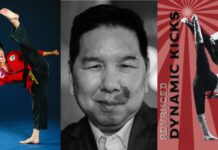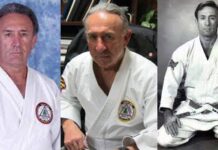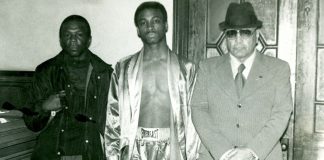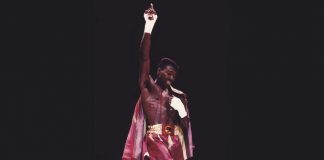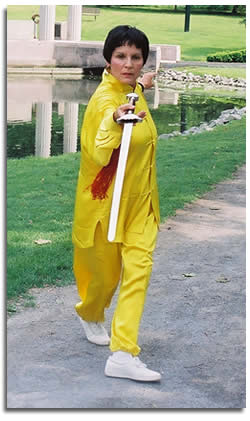 In 1989 at the age of 44 I had abdominal surgery that left my lower back muscles weak, or should I say weaker. My back had been unstable off and on for years. Having surgery only made it more unreliable. I felt strongly that I had to try and rebuild my body. That same year my husband and I went to a chamber music Sandra Balint TaiChi Swordconcert at Skidmore College. After the main program the announcer said there was an add-on bonus, a tai chi demonstration. Then a slightly built young Chinese man came on stage dressed in a white silk outfit. As he performed, the loosely hung silk began to ripple and the limbs underneath went soft as though he were moving in a cloud. I thought him the most exquisite tai chi player I’d ever seen. Then it was over. We never caught his name.
In 1989 at the age of 44 I had abdominal surgery that left my lower back muscles weak, or should I say weaker. My back had been unstable off and on for years. Having surgery only made it more unreliable. I felt strongly that I had to try and rebuild my body. That same year my husband and I went to a chamber music Sandra Balint TaiChi Swordconcert at Skidmore College. After the main program the announcer said there was an add-on bonus, a tai chi demonstration. Then a slightly built young Chinese man came on stage dressed in a white silk outfit. As he performed, the loosely hung silk began to ripple and the limbs underneath went soft as though he were moving in a cloud. I thought him the most exquisite tai chi player I’d ever seen. Then it was over. We never caught his name.
On March 10, 1990 I joined a tai chi class in Albany that had been advertised in a local “Knowledge Network” brochure. I’d been fascinated with Asian culture from early childhood. And I had wished to do this quiet exercise since Nixon’s opening up of China and catching footage of it on TV. That Saturday when I first met my martial arts teacher, Jiang Jian Ye, he insisted I call him “John.” For many years I was under the impression it was his first name. Both my father and brother are named John, so I thought he was just trying to dispense with formalities. From the blurb on his credentials in the advertisement, I’d read that he was a “visiting assistant professor of Physical Education and Dance,” and that he was currently teaching at Skidmore having come from Shandong province in China. I was excited that he was the real deal and I couldn’t wait to begin.
But I hadn’t thought about the language barrier. As the morning progressed I wondered just how well I was going to learn tai chi given my teacher’s limited English. But as it turned out it didn’t seem to matter much at all. He’d gotten a few key phrases down and was great at the art of gesturing. Anyway, as time went on I came up with my own solution: I imitated his every move. When he “grasped the bird’s tail” or spread his “wings like a white crane” (names I later learned), I followed. I absolutely wanted to make my body conform to his. I wanted to “flow like water,” “move like a cat,” even “root like a tree.” Years later he told someone in my presence that I had “smart eyes.” I definitely took that as a compliment.
Of course I didn’t always succeed. I once was highly embarrassed when I saw a photo in a local newspaper of teacher and our class doing tai chi. There I was with my shoulder’s drawn way up, not at all “released.” Like many beginners I thought I was calm. But there I was with my shoulders practically up to my ears. That’s why today when working with beginners I make a point of touching a cramped shoulder lightly while I whisper “relax.” Tai chi may be relaxing, but learning new forms and performing in front of others can sometimes choke up the qi.
As time went on, teacher began to get comfortable enough in English to request we write a testimonial. From the instructions on how to write it, I came to understand that that my opinion on my health was as important as my own doctor’s. I also learned that my wellness was definitely my own responsibility and that longevity depended on just how much effort I was willing to put into extending it.
Why did I do so well, having started tai chi in my 40s? I put it to commitment and excellent teachers (Sifu and his wife Lu Yuzhi), as well as the exposure to so many talented invited guest teachers. Over the years we have been privileged to have some of the best in the business offer us classes: Pan Qing Fu of Canada, known as “Iron Fist,” Grandmaster Chen Zhen Lei of China and Grandmaster Xue Nai Yin of New Zealand, to name a few. Add to these the annual trips to the Zhang San Feng Festival until Master Jou Tsung Hwa’s untimely death in 1998 and it becomes clear just how lucky I felt. Master Jiang had greatly admired Master Jou and spoke of him often at our school. So his passing not only left teacher feeling adrift, but I too felt I had lost not only a mentor but a friend. As a beginner student I purchased Master Jou’s The Tao of Tai-Chi Chuan: Way to Rejuvenation. It’s the book I go to with any martial arts question first; it’s the first book I recommend for beginners.
I have also done well in my martial arts studies because I have a teacher with a can-do attitude. Through Sifu Jiang’s own commitments, I have seen first hand what hard work means, as well as what it can achieve. I met him seven months after he arrived in the United States. And I saw how he and his family struggled to build a first rate school on a shoe string they hoped wouldn’t snap. I saw the going-without, done without complaint. I marveled at and admired their talent and their work ethic. And I felt exceedingly lucky to be a part of the studio they were creating. What I saw firsthand was dedication – dedication to their martial arts and to their students: young, old or in between, healthy or not, skilled or not, it didn’t matter; only commitment mattered, commitment to getting well, better, stronger or just plain working at keeping what you had.
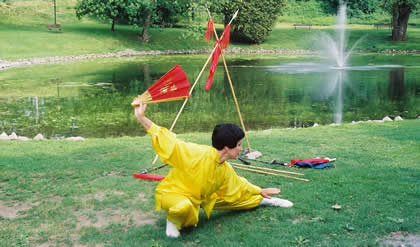
And where has my own commitment led? I came to Jiang Laoshi to get into shape, to regain strength and to learn something beautiful. It’s been quite a journey. I have learned many valuable things including the idea that one’s back can go out for many reasons. That you must learn to gauge what you can shoulder, learn how to walk so your feet stick stolidly as you go forward, to consider well if an object should be carried by you alone or with others, or whether you even need bear the load at all. In truth, I’ve come to see that the back can actually be a metaphor for one’s life.
I decided to use tai chi and qigong to regain my health after two major setbacks. I had injured my back in two separate falls. In the one I slipped on a patch of black ice and landed on a cement sidewalk; in the other I fell off a ladder, struck a wooden bench and landed on a wooden floor. The first happened in November of 1996. A MRI showed that I had injured my sacroiliac joint. I had landed hard on my back, primarily on my right side. I found it difficult to walk without pain in my right leg. Then my right foot would on occasion just flap and I’d temporarily lose my balance. I went to physical therapy, then after two months when the insurance ran out, I went to a private chiropractor and paid out of pocket.
After several months I wanted to do more, to start martial arts again, this time in a senior’s class. I wasn’t even sure I could manage that. I hurt when I attempted to do very simple stretches. But I was determined to start the recovery process. I also continued exercises at home that I had learned from the therapist on my last covered session. My husband bought me an exercise mat. He also wheeled me around in a wheelchair when I could no longer stand while shopping. But mostly what I did was listen to my body. I learned to move cautiously. I decided to do a bow stance that I learned in tai chi which slants the body rather then bends it over. In a 70/30 stance with most of the weight on the forward leg I could lean easily over the sink’s edge, in a Wu style move. I did this posture when I wanted to brush my teeth and when I had to reach something lightweight in a middle range. Bending over was out of the question. Every move had to be weighed as to whether it would cause my back to give way, which would send me to the floor. Without proper back support throughout my day, I quickly realized that many activities I had taken for granted were simply not doable. It was a real eye opener.
However, I did start to improve. My back did become stable again. The pain in my lower right leg that I’d had all year was starting to lessen. By August I asked Sifu Jiang if I could try studying sword again, in semi-private lessons. He agreed. And I was thrilled. During lessons he always kept an eye on my face, if he saw any fatigue or pain, he made me stop. As time went on, however it was clear to both of us that I was improving. Then on August 31, 1997, the day Princess Di was killed, I fell off a boat ladder into the cabin of our 30-foot sloop. I had been distracted and in a hurry to prepare the boat for company. I’d also felt terribly sad that two young people had had their lives ended. After striking the wooden bench and flipping onto the floor, I thought every bone in my spine had shattered. I was so certain of it, I didn’t even want to move. Then I thought I could and was relieved to be able to gradually stand. Over the course of the next hour I felt like a 40 pound rock had been placed between my shoulder blades. I found it difficult to breathe. X-rays showed that I had collapsed my left lung and broken two ribs. I had also re-injured my back. In the hospital I was acutely aware that I was going to have to start all over again. It was painful just lying there still.
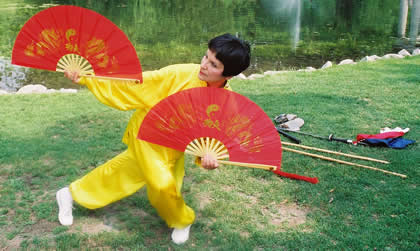
When it was clear the lung was going to stay inflated and the bones were healing well, I started back again with the seniors. I was certain that the demanding moves of many of the martial arts routines I’d learned in the past were not going to be in my future. My back would ache from just sitting too long. My right leg remained weak. It would fatigue easily and I often elevated it to find relief. But I continued with my classes. Gradually I took on more. I again joined the adult classes in the evening but still loved working out with the seniors.
In 1999 I competed in Master Malee Khow’s 1st International Championships in Connecticut. I went there to do “my personal best.” I had worked hard to relearn Mu Lan Double Fan, with the help of Lu Yuzhi, Sifu’s wife. I also entered to compete in four other disciplines: Hao, Wu, Sun and Tai Chi Palm. When the winners were announced each time, I could not believe the results. I had earned a medal in each. Between events I ran to find my teachers to thank them. In 2002 I again decided to challenge myself and went this time to Master Khow’s 2nd International Championships. This time I competed in Zhaobao, Wu, Sun, and Chen Short Staff and a Long Staff. I also performed a group weapons routine with the seniors in the same Long Staff routine. It was an exciting time. We seniors took first place and I again went 5 for 5 in my individuals. I came away convinced that hard work plus commitment can lead to success, more times than not.
Presently, I am still studying with the seniors, but I am also studying with other groups as well. It’s been wonderful to be back into things, after a number of setbacks. My back at times still gets achy, but I know it will recover. I am convinced now more than ever that it’s good to get your back up for the things you care about. And I know that more times than not we can come back from most setbacks. For sure I have the necessary safety nets: a great backup system of friends, family and teachers. I believe strongly in the importance of being connected in mind, body and spirit. I’m convinced that when they all finally come back into balance is when we begin to be well. I also believe that my 13 years of tai chi has taught me about what I can actually shoulder, what I need to ask help shouldering, and what I don’t need to shoulder at all. Finally I feel with great certainty that there are also some weights we place on our backs that actually add to its own great strength. Martial arts is one of them.
I’m convinced that a good fate brought Sifu Jiang and I together. In 1991 I was performing with him at the New York State Education Department in downtown Albany. Afterwards he gave me a copy of a newspaper article for my “archives.” I was really pleased, looked at it briefly and tucked it away. Later that day I showed it to my husband. “That’s him!” he said. “The same guy at the concert.” I looked closer. Sure enough! There was “John” in a pair of white Chinese silks doing a brush-knee step!
Written by Sandra Balint for KUNGFUMAGAZINE.COM
© COPYRIGHT KUNGFUMAGAZINE.COM, ALL RIGHTS RESERVED.
All other uses contact us at gene@kungfumagazine.com



